Discover Top Hiking Trails In Washington State: Scenic, Diverse, Unforgettable Adventures Await!
Let me take you on a journey through Washington State’s hiking paradise, where every path tells its own story. I’ve trekked up the misty Cascades and ambled along the peaceful shores of the Olympic Peninsula, and now I’m inviting you to join me.
Washington’s trails are a mosaic of Mother Nature’s best work, perfect for any adventurer, whether you’re a day hiker or a backpacking buff.
Ready for an insider’s peek into the most memorable trails? We’ll wander amidst ancient forests, gaze at pristine alpine lakes, and bask in the grandeur of towering mountains.
From the hidden corners of the Hoh Rainforest to the expansive views from North Cascades, let’s explore my top 14 hiking trails that showcase the diverse beauty of Washington.
Pack your curiosity and a sturdy pair of boots—it’s time to hit the trails and create stories of our own!
The Enchantments Trail, Okanogan-Wenatchee National Forest
This demanding 18-mile route, aptly named the “Enchantment Core,” will take even the most seasoned hiker through a grueling, yet rewarding journey of over 4,500 feet of elevation gain.
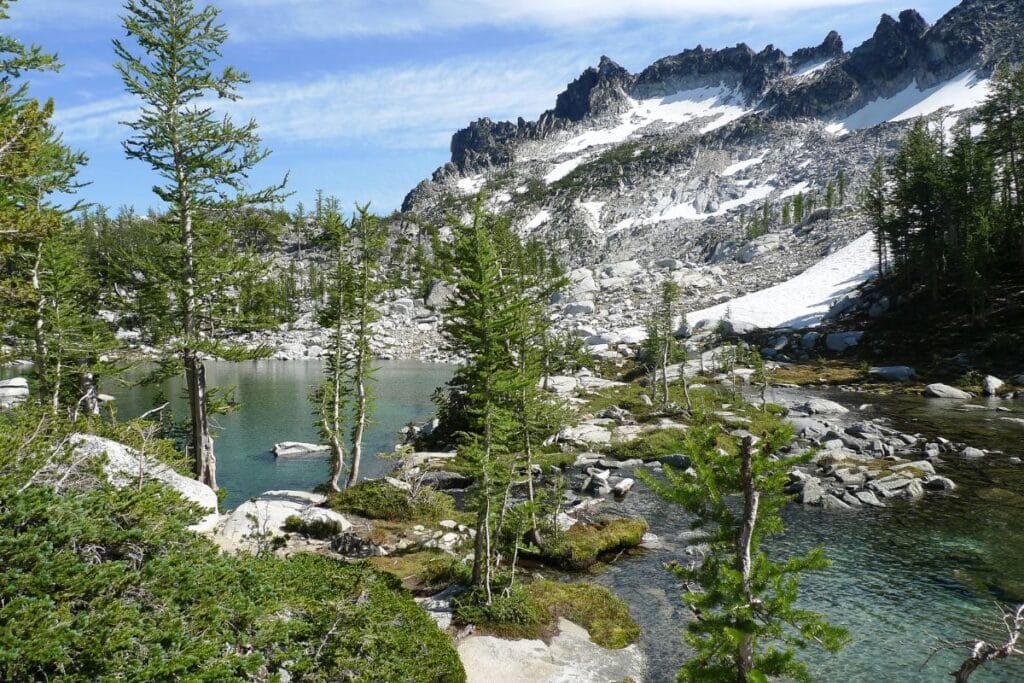
The trail boasts a diverse array of wildlife. Keep an eye out for nimble mountain goats leaping across rocky outcrops, black bears foraging in distant meadows, and playful marmots whistling from their burrows. This abundant wildlife adds a vibrant dimension to an already captivating landscape.
A landscape punctuated by craggy peaks and mesmerizing interlinking alpine lakes unfolds as you traverse this challenging trail. The climb up Aasgard Pass, while daunting, offers a panoramic view that is simply awe-inspiring. The lake-studded upper basin is a sight to behold, especially the shimmering waters of Colchuck Lake, a must-see that justifies every bead of sweat shed along the ascent.
Hiking the Enchantments Trail is an opportunity to immerse yourself in nature, with camping spots that let you wake up to the crisp mountain air and the soft chirping of birds. It’s more than just a hike; it’s an adventure filled with moments that make every strenuous step worth it.
Hiking the Enchantments in One Day
Completing the entire 18-mile Enchantments Trail in one day is an ambitious endeavor that requires a high level of fitness, preparation, and determination. Known as a “thru-hike,” this intense journey typically takes between 10 to 14 hours, depending on your pace and how often you stop to rest or appreciate the spectacular scenery.
Hiking the trail in one day means starting at the crack of dawn, or even before, to ensure you finish before nightfall. While it’s a challenging feat, a one-day hike allows you to experience the awe-inspiring beauty of the Enchantments without having to secure a coveted overnight permit.
Remember, safety should be your utmost priority. Be prepared with the right gear, ample food and water, and a well-studied map of the trail. Always let someone know your plans and estimated return time, and check the weather forecast before setting out. This endeavor should only be attempted by hikers who are well-prepared, physically fit, and have experience with long, strenuous hikes.
Mount Rainier’s Wonderland Trail
Traversing the foothills of the majestic Mount Rainier, the Wonderland Trail is a true jewel in Washington State’s crown. This 93-mile journey presents a rigorous expedition, immersing hikers in the tranquil beauty of the Pacific Northwest.
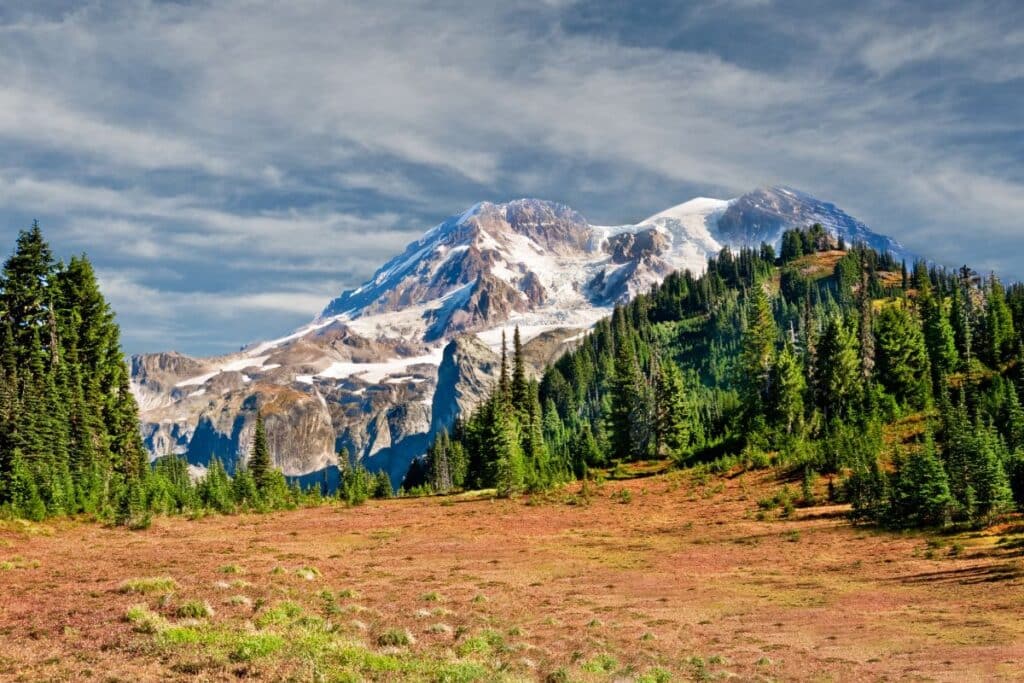
Replete with formidable ascents and descents and totaling an elevation gain of about 22,000 feet, the Wonderland Trail is not for the faint-hearted. It presents a strenuous undertaking that demands strength, stamina, and a sturdy pair of hiking boots.
Throughout the trail, hikers are rewarded with bountiful wildlife sightings. Graceful herds of elk can often be spotted in clearings, while black bears rummage through berry patches. Marmots scuttle around the rocky terrain, and keen bird watchers will relish the opportunity to spot an array of birds soaring overhead.
The Wonderland Trail is characterized by its scenic beauty, with meadows carpeted in a vibrant array of wildflowers and unforgettable panoramic views of Mount Rainier’s imposing silhouette. Noteworthy locations such as Panorama Point and Indian Bar offer stunning vistas that warrant a pause to appreciate the remarkable surroundings fully.
Whether you’re tackling the trail in sections or undertaking a multi-day backpacking adventure, the Wonderland Trail offers an array of outdoor activities. From hiking through diverse ecosystems and camping under star-studded skies to spotting wildlife and capturing photographs, the Wonderland Trail serves as a playground for nature enthusiasts.
Obtaining a Walk-up Permit for the Wonderland Trail
Due to the popularity and delicate ecology of the Wonderland Trail, the National Park Service limits the number of hikers on the trail each day through a permit system. While a significant portion of these permits are reserved through a lottery system in advance, a limited number are set aside for walk-up hikers.
Every day during the hiking season, approximately 30% of the permits are available for walk-up hikers. These permits are issued on a first-come, first-served basis, so it is essential to arrive early at the ranger station if you are attempting to secure one. This can often mean arriving the day before you plan to start your hike.
To request a permit, go to one of the wilderness information centers or ranger stations such as the Longmire Wilderness Information Center or White River Wilderness Information Center. You need to provide details of your proposed itinerary, and remember, flexibility can increase your chances of obtaining a permit. Once issued, the permit will include your assigned campsites along the trail.
Keep in mind that securing a walk-up permit can be uncertain, especially during peak hiking season. Hence, it’s best to have alternative hiking plans ready just in case.
Hoh Rainforest Hall of Mosses Trail, Olympic National Park
This relatively short and easy 0.8-mile loop trail is perfect for all skill levels, inviting hikers to lose themselves in a world swathed in emerald greens and vibrant blues.
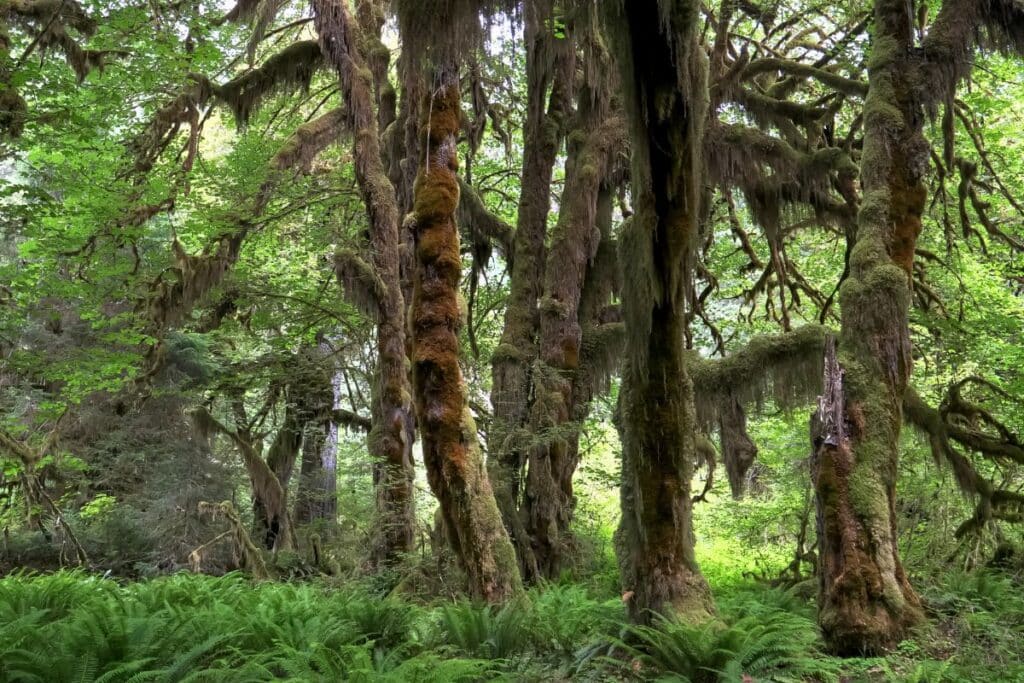
A remarkable variety of wildlife call this rainforest home. With some luck and a quiet tread, you may spot majestic Roosevelt elk grazing in meadows, black-tailed deer darting through the underbrush, and a multitude of bird species fluttering in the canopy above.
The trail’s namesake mosses create an enchanting landscape, clinging to towering trees and creating an otherworldly atmosphere that feels straight out of a fairy tale. Ferns line the path, their delicate fronds gently brushing against hikers as they traverse this verdant wonderland. The steady hum of life around you makes the rainforest feel almost sentient.
Among the trail’s highlights is the Mineral Creek Waterfall, a serene spot where the gentle gush of water adds to the rainforest’s tranquility. Whether you’re hiking, capturing the unique landscapes with your camera, or birdwatching, the Hoh Rainforest Hall of Mosses Trail promises a soothing retreat into nature’s mystical realm.
What is the difference between the Spruce Nature Trail and the Hall of Mosses?
While both the Spruce Nature Trail and the Hall of Mosses are located in the Hoh Rainforest of Olympic National Park, they offer distinct experiences. The Hall of Mosses, at 0.8 miles, focuses on the rainforest’s lush, moss-draped trees, creating a unique, verdant landscape.
On the other hand, the slightly longer Spruce Nature Trail, about 1.2 miles, provides a more diverse scenery. It meanders through both old-growth rainforest and riparian (riverside) ecosystems, offering a glimpse of the Hoh River and potential sightings of the Roosevelt elk.
Pacific Crest Trail Section J, Snoqualmie Pass to Stevens Pass
Draped across the heart of Washington’s Cascade Range, the Pacific Crest Trail Section J is a thrilling journey from Snoqualmie Pass to Stevens Pass. This stretch, extending over approximately 70 miles, is not just a hike but an expedition that challenges hikers with its considerable elevation gains and losses, taking them through rugged terrains and serene alpine environments.
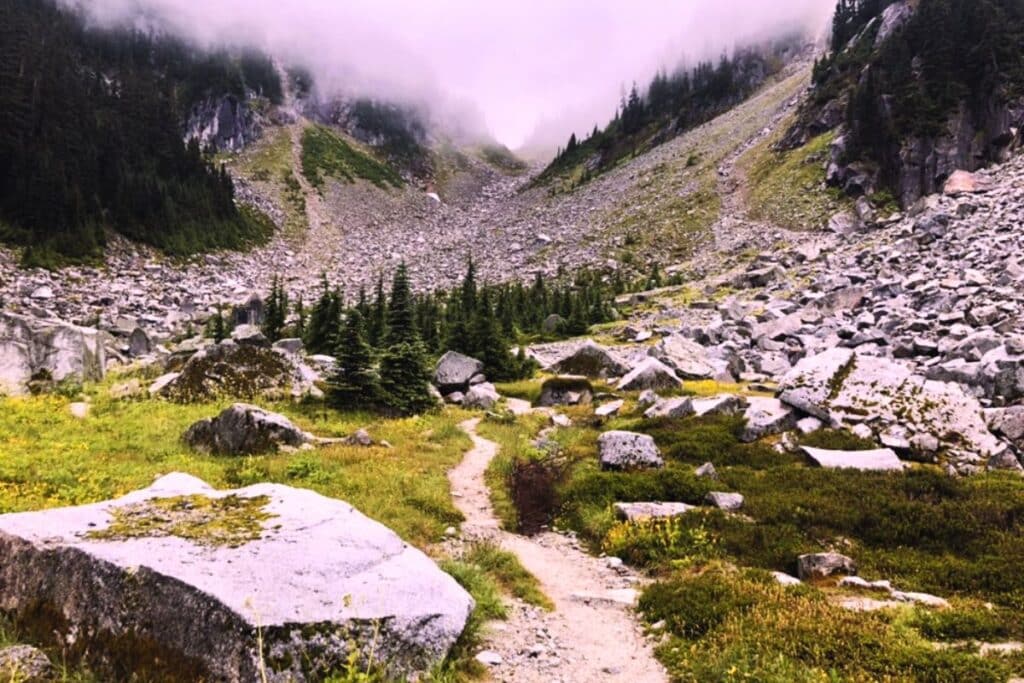
The trail is teeming with wildlife that are iconic to this part of the country. Pika can often be heard calling from rocky slopes, while marmots bask in the sun on warm summer days. Be alert for sightings of black bears foraging for berries and mountain goats navigating the craggy peaks.
This segment of the Pacific Crest Trail is renowned for its remarkable natural beauty. Hikers traverse through vibrant alpine meadows, under the shadow of towering peaks, and are offered incredible views of the glaciated massif, Glacier Peak. Unforgettable spots like the crystal-clear Spectacle Lake and the majestic Cathedral Rock warrant a pause to admire their breathtaking beauty.
Whether you’re embarking on a multi-day trek and camping under the stars, or setting out for a day’s hike to catch a glimpse of the wildlife, the Pacific Crest Trail Section J is an enriching experience, offering a window into the raw, captivating allure of Washington’s wilderness.
Time Required for the Washington Section of the PCT
The Washington section of the Pacific Crest Trail (PCT) extends for about 500 miles, traversing some of the state’s most rugged and beautiful terrains. The length of time it takes to complete this section can vary greatly depending on individual pace, weather conditions, and the amount of time spent resting or exploring along the way.
On average, most hikers take between 3 to 4 weeks to complete this segment. This estimate assumes a hiking pace of about 20-25 miles per day, which is common for thru-hikers in good physical condition. However, for those who prefer a more leisurely pace or want to take more rest days, it could take over a month to complete this section of the trail.
Remember, the journey is not just about covering distance; it’s also about soaking in the breathtaking landscapes and enjoying the unique experiences along the way. Therefore, plan your hike according to your comfort and capabilities, and always prioritize safety and enjoyment over speed.
Rialto Beach to Hole-in-the-Wall, Olympic National Park
Blessed with natural wonders, the trail from Rialto Beach to Hole-in-the-Wall in Olympic National Park is a captivating coastal journey that marries the ocean’s power with the serene beauty of the Pacific Northwest. This relatively easy and flat 4-mile round trip offers an intimate encounter with Washington State’s stunning coastline, suited to hikers of all levels.
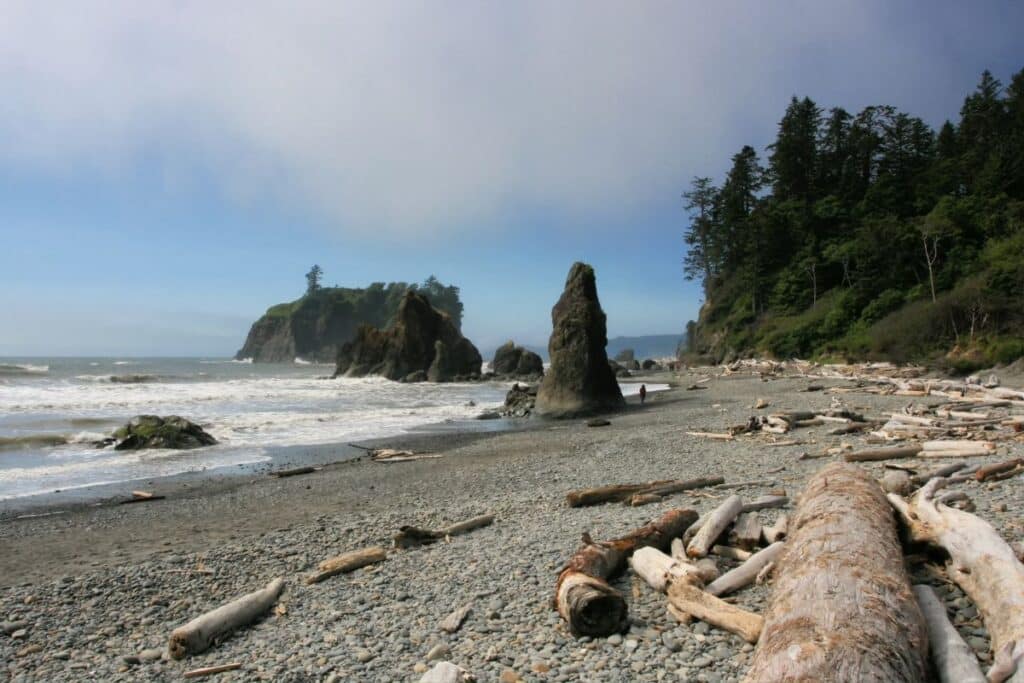
Diverse marine wildlife adorns the journey along this shore. The sky above is often graced by the magnificent flight of bald eagles, while seals bask on off-shore rocks and playful sea otters can be spotted in the surf.
This trail is a beautiful testament to the Pacific’s wild edge. Hikers are gifted with panoramic coastal views, where the constant ebb and flow of the tides shape the landscape. Spectacular sea stacks rise from the ocean, their silhouettes adding a dramatic touch to the skyline.
The Hole-in-the-Wall rock formation is the trail’s namesake and a must-see landmark. This natural archway, carved by the relentless sea, provides a unique frame for capturing the awe-inspiring ocean views.
Whether you’re hiking with the crash of waves as your soundtrack, exploring tide pools rich with marine life, or simply soaking in the wildlife, the journey from Rialto Beach to Hole-in-the-Wall offers a unique and rewarding Pacific experience.
Where to Camp at Rialto Beach?
Camping at Rialto Beach offers an immersive experience in the beauty of the Pacific Northwest’s rugged coastline. However, it’s important to know that camping is not permitted directly on Rialto Beach itself. Instead, camping is allowed on the beach north of Ellen Creek, which is approximately 1.5 miles from the Rialto Beach parking lot.
The beach campsites offer unique views of the ocean, the sound of crashing waves, and opportunities for wildlife viewing. When selecting a site, campers are advised to set up above the high tide line, and it’s always wise to check the tide tables to avoid any unexpected surprises.
All campers are required to have a wilderness permit, which can be obtained from the Wilderness Information Center in Port Angeles or the South Shore Lake Quinault Ranger Station. It’s also recommended to bring a bear canister for food storage as these critters are common in the area. Please follow the Leave No Trace principles to protect this beautiful area for future visitors.
Remember, the weather can change rapidly in this area, so be prepared with appropriate gear for a variety of conditions, and always respect the power of the ocean.
Skyline Trail, Mount Rainier National Park
The Skyline Trail in Mount Rainier National Park is a delightful revelation of the park’s varied treasures. A moderate, 5.5-mile loop that begins and ends at the Paradise area, it offers hikers an unforgettable journey through a landscape bejeweled with wildflower meadows, ancient glaciers, and breathtaking views of Mt. Rainier itself.
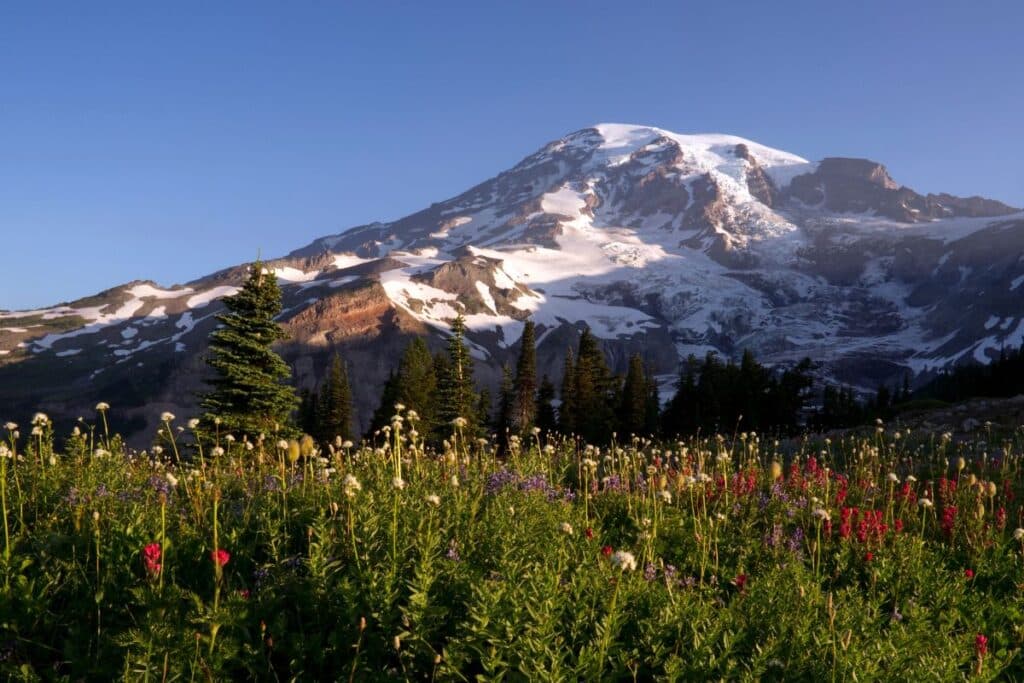
The trail is a living tableau of wildlife. Keen observers may catch sight of black bears foraging for food, or marmots whistling warnings to their kin. Birds fill the air with their songs, adding an auditory layer to the already rich sensory experience.
The Skyline Trail rewards every step with a panorama of natural beauty. The blooming wildflowers paint a vibrant contrast against the snowy backdrop of Mt. Rainier, while views of the park’s storied glaciers serve as a humbling reminder of nature’s power and timelessness.
Unmissable landmarks along the route include Myrtle Falls, a scenic waterfall that plunges gracefully beneath a quaint footbridge. The overlook onto Paradise Glacier is another breathtaking vista that invites hikers to pause and take in the majesty of their surroundings.
Whether you’re an avid hiker pushing your boundaries, a photographer capturing the ever-changing play of light on the mountain, or a nature enthusiast observing the unique wildlife, the Skyline Trail offers an immersive and awe-inspiring experience of Mount Rainier’s stunning beauty.
Do you need a permit for Skyline Trail Mt Rainier?
For day hiking on the Skyline Trail, you do not need a special permit. However, if you’re planning to do any overnight backcountry camping in the park, you will need a Wilderness Permit. Note that these can be in high demand during the peak summer months, so it’s advisable to book in advance if possible.
Where do you park for the Skyline Loop trail in Mt Rainier?
Parking for the Skyline Loop Trail is available at the Paradise parking lot in Mount Rainier National Park. Paradise is one of the main visitor center areas in the park, located on the south slope of Mount Rainier. Do keep in mind that this parking lot can get quite crowded, especially during the summer months and on weekends. Arriving early in the day can help secure a spot. Also, remember to display your park pass or proof of entrance fee payment in your vehicle.
Cape Alava Loop (Ozette Triangle), Olympic National Park
The Cape Alava Loop, also known as the Ozette Triangle, in Olympic National Park is an enchanting 9.4-mile journey that takes you through the heart of coastal Washington. The trail, moderate in difficulty, serves as a gateway to the wild, rugged beauty of the Pacific Northwest coastline.
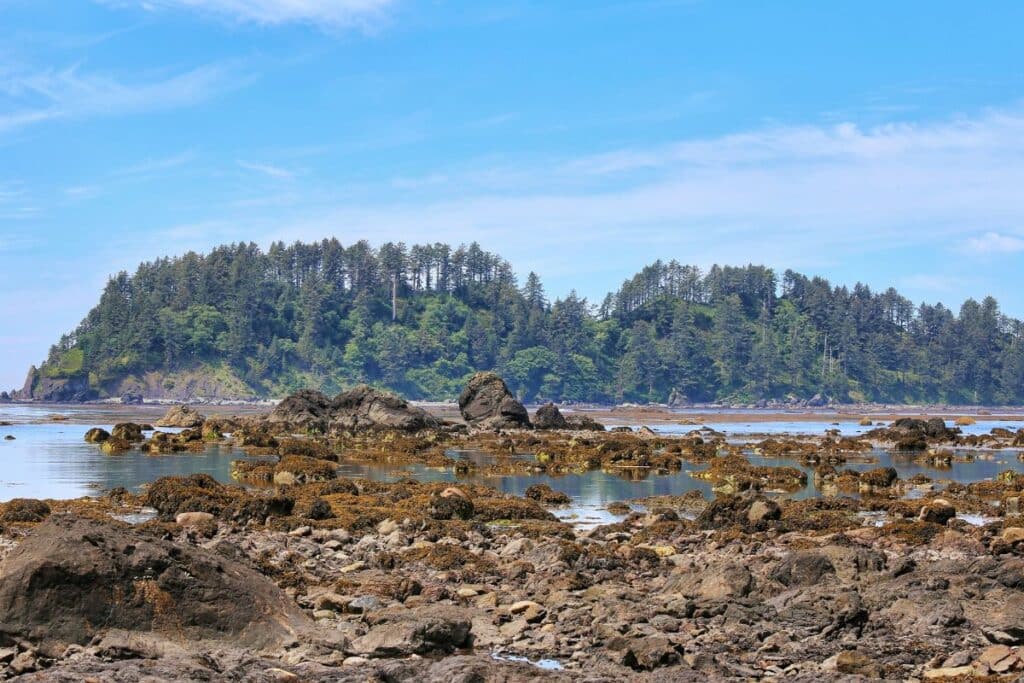
The trail boasts a diverse array of wildlife. It’s not uncommon for hikers to witness whales breaching in the distance, seals bobbing in the surf, or majestic bald eagles soaring high above the tree line. These encounters lend an element of surprise and excitement to the trek.
As hikers traverse through verdant coastal forests, emerge onto sandy beaches, and follow the coastline, they are treated to an evolving landscape. Intriguing features like the ancient petroglyphs at Wedding Rocks add a touch of mystery and provide insight into the region’s rich cultural history.
Cape Alava, the westernmost point in the contiguous United States, is another highlight. This spot offers sweeping ocean views and a quiet solitude that allows for a moment of reflection amidst nature’s grandeur.
Whether you’re hiking through the lush forest, beachcombing along the rugged shore, or immersing yourself in wildlife viewing, the Cape Alava Loop presents a rich tapestry of experiences that resonate with the primal beauty of Olympic National Park.
North Cascades National Park’s Cascade Pass Trail
The Cascade Pass Trail in North Cascades National Park is an exquisite 7-mile round-trip journey that showcases the dramatic landscapes for which the park is renowned. This moderate-to-strenuous trail brings hikers up close to the awe-inspiring beauty of the North Cascades.
As you embark on this trail, keep an eye out for the park’s resident wildlife. Marmots are often seen perched on rocks, their whistles echoing through the valleys, while black bears may be spotted foraging in the distance. Eagles often grace the skies above, adding an extra sense of wild grandeur to your hike.
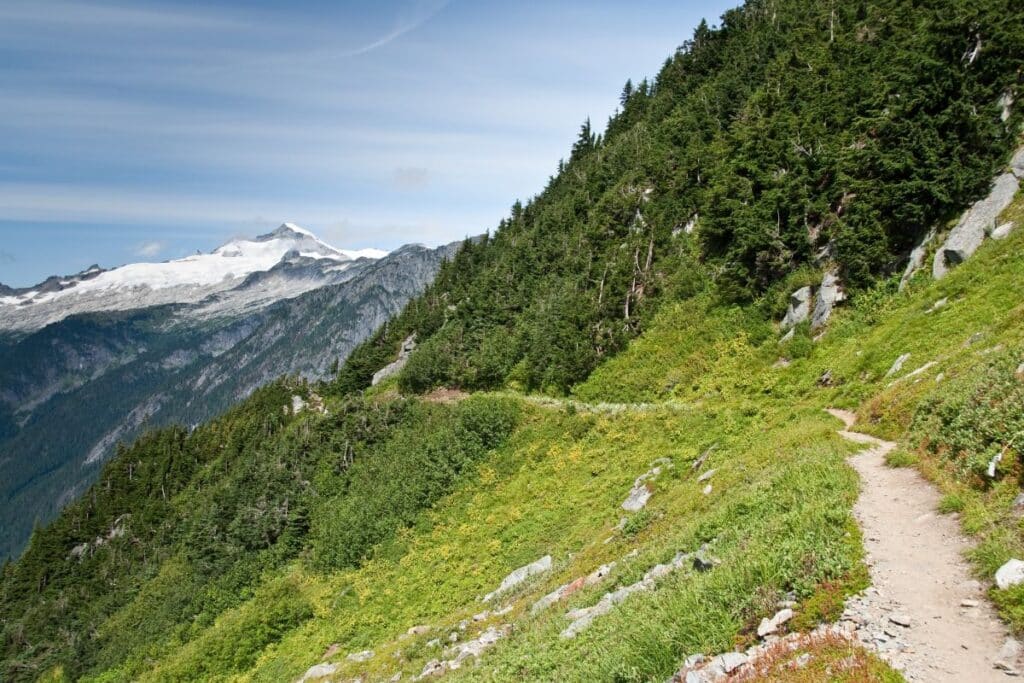
The Cascade Pass Trail is a breathtaking display of the North Cascades’ varied ecosystems. Hikers traverse through dense forest before ascending into lush subalpine meadows and finally into the world of ice and rock. Sweeping views of surrounding glaciers and mountains offer a stunning backdrop throughout the journey.
Cascade Pass, the trail’s namesake, offers panoramic views that are truly mesmerizing. Another unmissable spot along the trail is the Sahale Arm, an extension of the trail that promises even more remarkable vistas.
Whether you’re hiking to take in the unmatched views, planning an overnight camping excursion, or hoping to spot wildlife, the Cascade Pass Trail offers an authentic taste of the wild North Cascades landscape.
Mount Constitution Loop, Moran State Park
The Mount Constitution Loop in Moran State Park is a spectacular 6.7-mile trek that whisks hikers through the heart of the Pacific Northwest’s natural beauty. This moderately challenging trail encapsulates the essence of the San Juan Islands, with its lush old-growth forests, panoramic views, and opportunities for wildlife encounters.
The park is home to a variety of wildlife. From bald eagles gracefully soaring overhead to black-tailed deer quietly browsing in the undergrowth, nature lovers will appreciate the biodiversity that this trail offers. A chorus of birdsong adds an auditory layer to the wilderness experience, making this a prime location for birdwatchers.
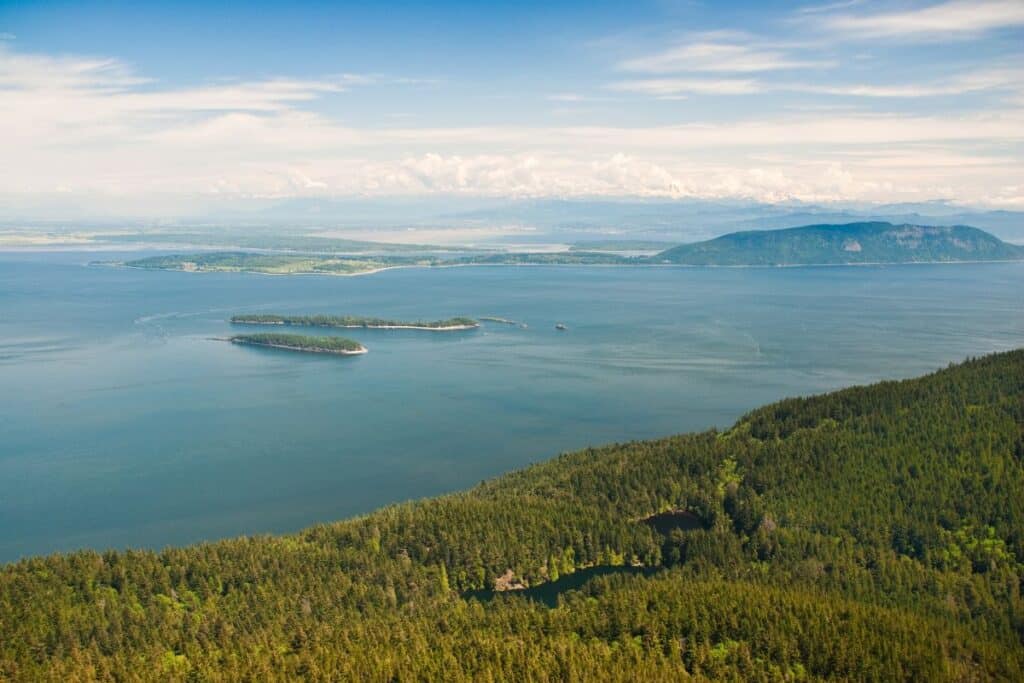
The trail meanders through the verdant old-growth forest, offering hikers a taste of the region’s pristine ecology. The views from the summit of Mount Constitution, the highest point in the San Juan Islands, are breathtaking. On clear days, you can see Mount Baker, the Olympic Mountains, and a plethora of surrounding islands.
Twin Lakes is another unmissable spot along the trail, offering a tranquil setting for rest and reflection. In the warmer months, a refreshing swim in the lake provides the perfect conclusion to your hike.
Whether you’re hiking to the summit, birdwatching among the forest’s towering trees, or seeking a refreshing swim in Twin Lakes, the Mount Constitution Loop promises a rich and rewarding adventure in the heart of Moran State Park.
Heliotrope Ridge, Mount Baker
The Heliotrope Ridge Trail on Mount Baker is an exhilarating 5.5-mile round trip expedition that rewards hikers with an intimate view of one of Washington’s most iconic glaciers. This moderately strenuous trail is a popular route for mountaineers heading for Baker’s summit and hikers seeking breathtaking glacier views.
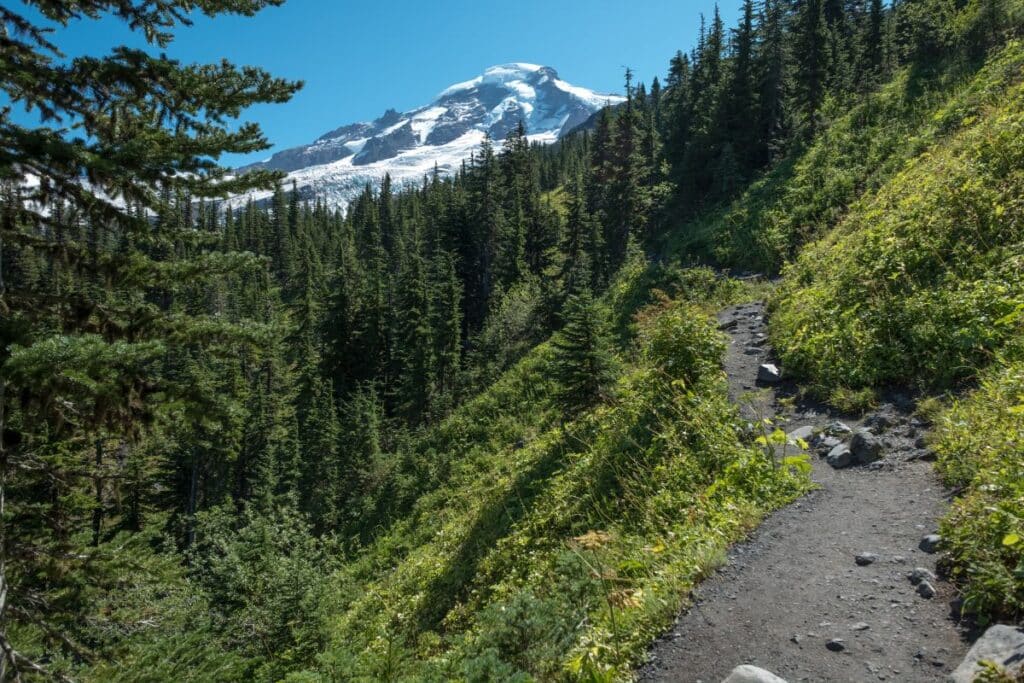
Nature’s wonders unfold around every corner. Keep an eye out for the area’s black bears and marmots, often spotted in their natural habitats, adding a sense of raw wilderness to the journey.
One of the most distinguishing features of the trail is its vibrant wildflowers. They paint the landscape with their vivid hues, contrasting beautifully with the white canvas of the nearby glaciers. The forceful power of cascading waterfalls and the silent might of vast glaciers, including the awe-inspiring Coleman Glacier, are equally impressive.
The Hogsback Camp, an unmissable spot along the trail, provides a stunning view of Mount Baker and the surrounding landscapes. It’s an excellent spot for rest and contemplation before the descent.
Whether you’re an experienced hiker seeking the thrill of a challenging trail, a nature lover mesmerized by the sight of glaciers, or a camper in search of unique landscapes, Heliotrope Ridge offers a compelling journey into the heart of Mount Baker’s wilderness.
Spray Park, Mount Rainier National Park
The Spray Park Trail in Mount Rainier National Park offers a captivating 6-mile trek that immerses hikers in the vivid landscapes and abundant wildlife of the Pacific Northwest. This moderately strenuous trail winds its way up through old-growth forest, wildflower-strewn meadows, and past cascading waterfalls, revealing sweeping views of Mount Rainier.
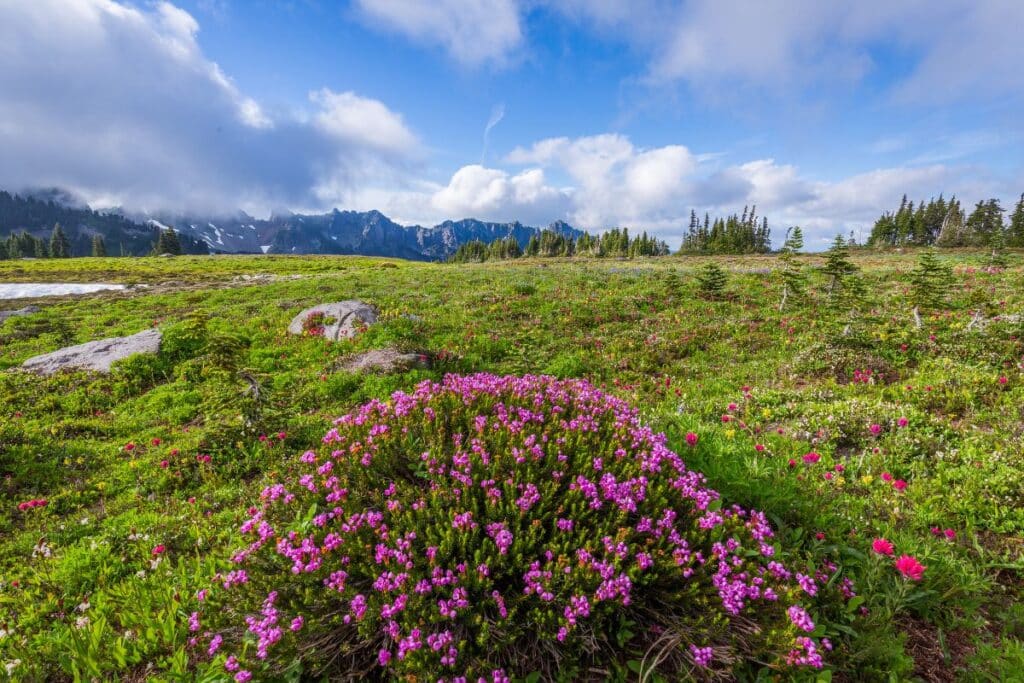
Wildlife enthusiasts will revel in the opportunity to spot black bears, marmots, and elk in their natural habitats. Their presence underscores the vitality of this alpine ecosystem and provides thrilling moments of unscripted nature observation.
The journey unfolds with each step, leading hikers through a dreamlike landscape, where wildflower meadows compete for attention with stunning waterfalls and commanding mountain views. Spray Falls, a torrent of water crashing down amidst a lush green backdrop, is a breathtaking sight you won’t soon forget.
Spray Park itself is an unmissable spot. This alpine meadow blooms with vibrant wildflowers in the summer, offering a natural canvas of colour with Mount Rainier’s snowy peak as the picture-perfect backdrop.
The Spray Park trail is a hiker’s paradise, offering countless opportunities for stunning photography and immersive wildlife viewing. If you are keen to experience the unspoiled beauty of Mount Rainier National Park, this trail is a must-visit.
Shi Shi Beach and Point of Arches, Olympic National Park
The Shi Shi Beach and Point of Arches trail is a captivating 8-mile round trip journey located in Olympic National Park. This moderately challenging trail beckons adventurers with its enchanting coastal views, flourishing marine life, and the otherworldly allure of sea stacks and tide pools.
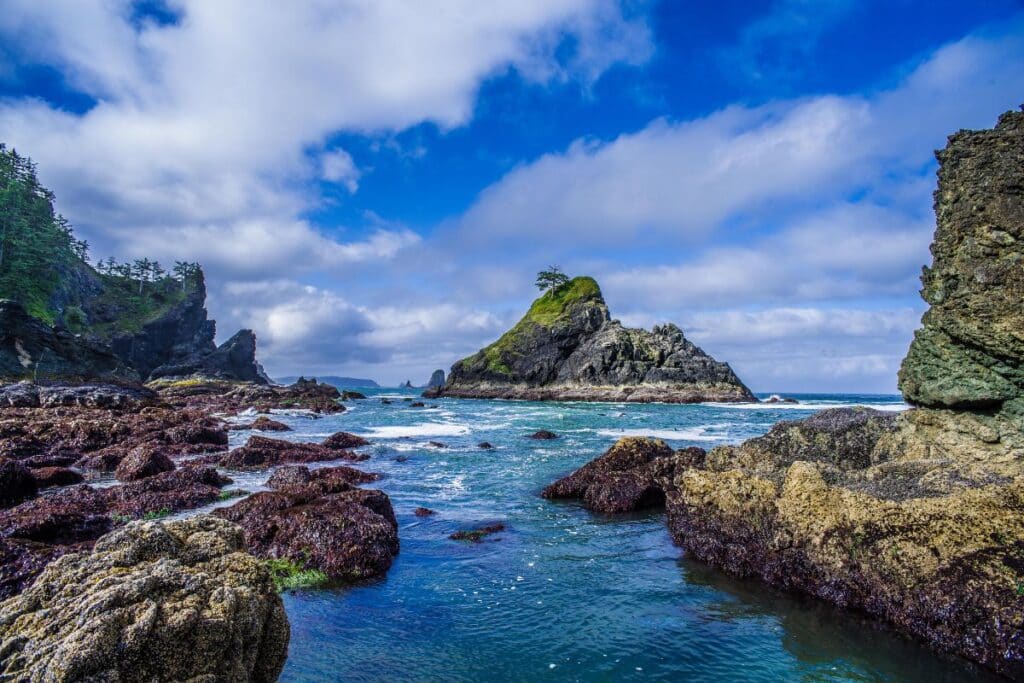
As you traverse the trail, keep an eye out for the area’s rich marine and avian wildlife. From seals and sea otters frolicking in the waves to an array of seabirds dotting the sky and shore, this trail offers an immersive nature experience.
The trail guides you along the rugged Washington coastline, affording sweeping views of the Pacific Ocean. The dramatic sea stacks standing tall amidst the surf, coupled with fascinating tide pools brimming with aquatic life, make for a memorable exploration.
One of the most unmissable spots on this trail is the Point of the Arches, a mesmerizing sea stack formation that provides a stunning backdrop for photographs and quiet contemplation. This natural marine sanctuary changes with the tide, offering a different spectacle with every visit.
Whether you’re hiking for the sheer joy of it, combing the beach for natural treasures, or watching for wildlife, the Shi Shi Beach and Point of Arches trail offers a unique blend of marine and terrestrial wonders that won’t fail to captivate.
Hidden Lake Lookout, North Cascades
Hidden Lake Lookout trail in the North Cascades is an exhilarating 9-mile round trip journey, taking hikers into the alpine wilderness of Washington State. This strenuous trail promises rewards for those up to the challenge, offering panoramic views, encounters with wildlife, and the chance to spend a night in a historic fire lookout.
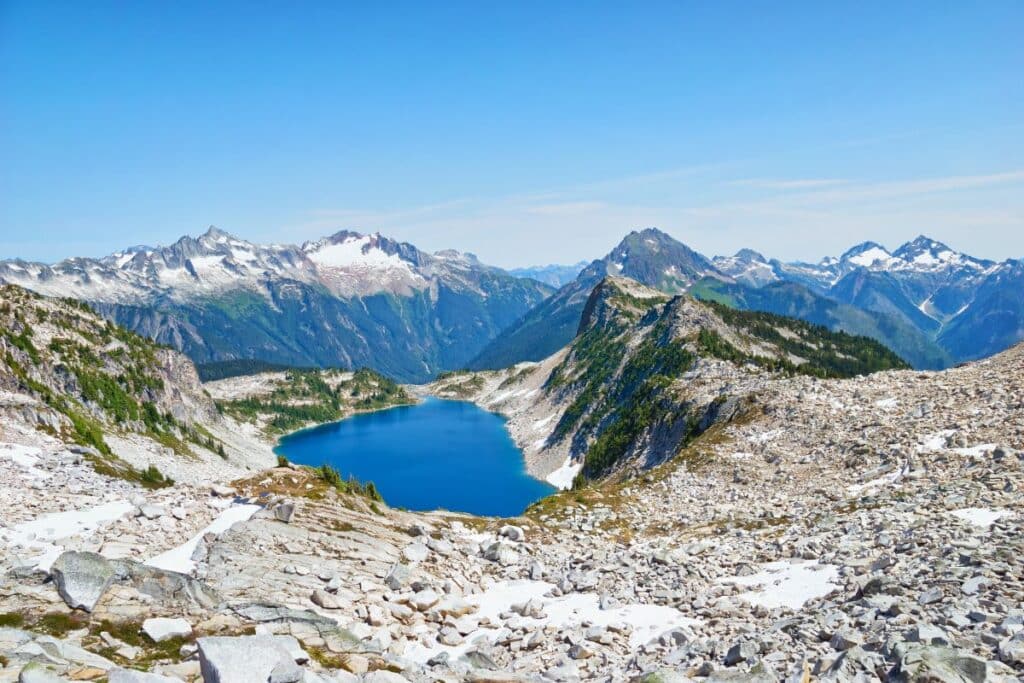
The trail is a wildlife hotspot, offering opportunities to spot marmots, pikas, and even mountain goats in their natural alpine habitat. These creatures add a dynamic layer to the adventure, giving a glimpse into the thriving ecosystem of the North Cascades.
The path winds through vibrant wildflower meadows and past glistening alpine lakes, showcasing the diverse landscapes of the region. It culminates in a breath-taking panorama at the Hidden Lake Lookout, an unmissable destination. The lookout, originally built in the 1930s for wildfire detection, now serves as a unique overnight shelter for hikers on a first-come, first-serve basis.
Whether your pleasure is a vigorous hike, an evening under the stars, or the chance to observe wildlife in its natural setting, the Hidden Lake Lookout trail delivers a robust and memorable outdoor experience. From the first step to the last, this trail encapsulates the majestic beauty of the North Cascades.
Goat Lake, Mountain Loop Highway
The Goat Lake Trail, located off the Mountain Loop Highway, offers an immersive 10.4-mile round trip hike through the pristine wilderness of Washington State. This moderately difficult trail delivers an array of natural highlights, from roaring waterfalls to tranquil alpine lakes, making it a favourite among local and visiting hikers alike.
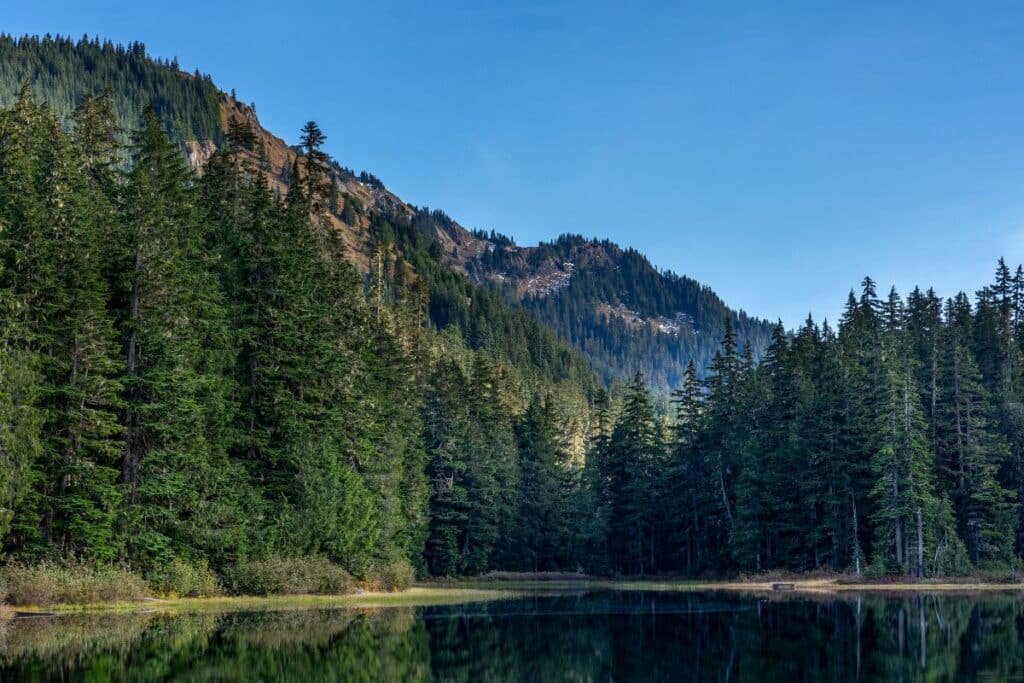
The trail is aptly named for the mountain goats that are frequently spotted in the area, and you may also catch sight of black bears from a safe distance. Observing these magnificent creatures in their natural habitat adds an element of thrilling unpredictability to the hike.
As you journey along the trail, you’ll pass through stunning old-growth forests, their ancient trees standing tall and silent, guardians of the land. Your senses will also be treated to the sound of rushing waterfalls and the sight of Goat Lake, a serene alpine body of water that is as beautiful as it is peaceful.
Goat Lake itself is an unmissable spot. Surrounded by mountain peaks and lush forest, its crystal-clear waters offer a refreshing break for the weary hiker. The area also provides opportunities for camping and fishing, making it an ideal spot for a multi-day adventure. The Goat Lake Trail encapsulates the diverse beauty of the Pacific Northwest, ensuring a memorable experience with each visit.
Conclusion
Washington State offers an abundance of diverse and scenic trails that beckon hikers of all experience levels. We invite you to delve into its natural wonders, but remember, exploring responsibly is crucial.
Tread lightly, leave no trace, and respect the wildlife – these spaces are as much their homes as our playgrounds. After all, it’s our collective duty to ensure these trails remain captivating for future generations.
We’d love to hear about your own experiences hiking in Washington – your adventures, the wildlife you encountered, the sunsets you witnessed. May your hikes be safe, fulfilling, and ever inspiring.

